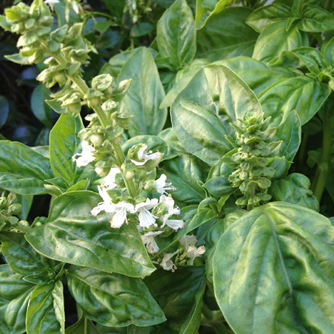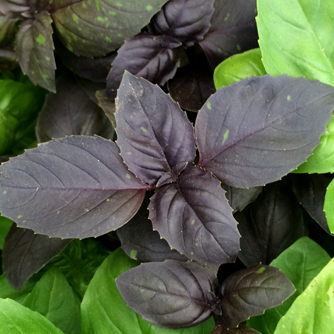Basil
BackBasil is an easy to grow herb with strong aromatic leaves that can be grown in pots or the ground. The fresh flavours of basil leaves make them a tasty addition to salads, soups and sauces. Basil belongs to the Lamiaceae family and produces flower spikes which attract bees and other beneficial insects.
There are many different types of basil species but the most popular is sweet basil or Italian basil (Ocimum basilicum). Sweet basil is an annual with large fleshy leaves and is the main ingredient of pesto. It’s also added to many other Italian sauces and dishes.
Other annual basil types include Thai, purple, lemon, cinnamon and even liquorice basil each with their own unique twist on the classic basil flavour. In climates with warm winters annual basils can keep going for more than a year but they lose their vigour and should still be replaced regularly. A few types are true perennials like the popular Greek basil (Ocimum obovatum) which has smaller leaves.
How To Grow Basil
All basils are quick growing plants that love the warmth of summer. They are happiest with at least 5 hours of sunlight but large leaved and purple leaf varieties will appreciate some afternoon shade in very hot regions. Keep the plants well watered and with regular fertilising you’ll have a good supply of leaves all summer long.

Sweet basil leaves
Basil is easy to grow from seed and can be sown directly into a garden bed or pot in a sunny position. Sow seed in September for warm and temperate areas and October for cool to cold areas. Keep moist and apply a solution of OCP eco-seaweed and OCP eco-aminogro weekly to encourage seedling growth.
Established seedlings and potted plants are also available throughout the spring and summer months from nurseries and garden centres.
Basil is prone to severe frost damage so only plant out when all danger of frost has passed.
Fertilising Basil
Basils are big feeders and the more you pick the more you need to feed. Mixing OCP eco-seaweed and OCP eco-aminogro together will give you a two-in-one organic stimulant and fertiliser. Apply this every 2-3 weeks and your basil plants will reward you with a continuous supply of sweet, healthy, plump leaves.
Pruning Basil
Prune off flower spikes to encourage bushiness and energy into more leaf production. Leave a few flowers towards the end of the season so you can collect seed for next year.

Sweet basil in flower
Pest and Disease Problems for Basil
Whilst basil is a pretty easy plant to grow there are a few pests to watch out for:
- Caterpillars – we’re not the only ones who love the taste of basil leaves. Read our caterpillar page for organic control techniques.
- Snails and slugs - protect seedlings with OCP eco-shield.
- Aphids, whitefly and mites can attack plants and should be controlled with an organic insecticide at the first sign of damage.

Purple basil


